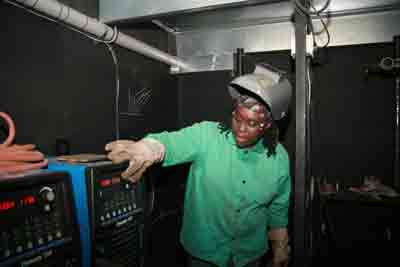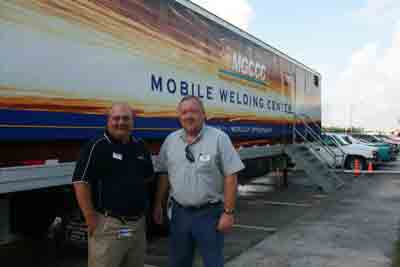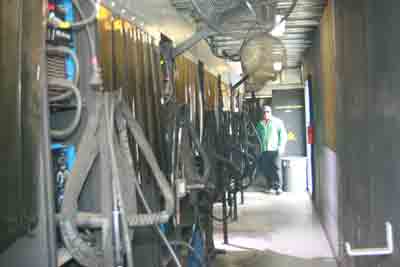A shortage of skilled welders may exist, but not if Mississippi Gulf Coast Community College (MGCCC) can help it. The college, with eight locations in southern Mississippi, recently partnered with the Mississippi Department of Employment Security, the WIN Job Centers (Workforce Investment Network) and two community colleges, Pearl River Community College and Jones County Junior College, to meet the sustained and increasing needs of industry in 18 southeastern counties. The result was a three-year grant that not only enabled the college to establish a center of excellence in welding, but also to develop stronger workforce partnerships and a sustainable training program. For MGCCC's center of excellence, the welding equipment of choice: multi-process welders and inverters from Miller Electric Mfg. Co.

(L-R) Mark Landry,
Workforce Director; Mike Leleux, Trinity Yachts; Larry Porter, WIRED Master Trainer
Part 1: Customized Training
The impact of the school's three-year grant, WIRED (Workforce Innovation in Regional Economic Development), funded by the US Department of Labor, is realized by more than just the community colleges and industry partners. Student's gain the credentials required by area business and are trained according to their needs. The customized training program, which was developed as part of the WIRED grant, includes more stringent testing guidelines that enable students to possess "stackable"-as well as nationally recognized-credentials that students can achieve prior to completion. The curriculum sequences students through the multiple welding processes in a way that ensures students successfully test according to American Welding Society (AWS) standards.
The college maintains an excellent rate of placement and never holds a student back. "If a student comes in with experience, we'll go from there," says Larry Porter, welding instructor at MGCCC and WIRED Master Trainer. "We'll test them to see what skills the students possess and begin building the student's skill set from that point, thus allowing the student to move into more advanced welding."
The school is in its third year of the WIRED grant, although training actually began in the second year. During the first year and a half, testing guidelines and upgraded labs were implemented to fulfill the grant's "center of excellence" purpose in welding. Further, the grant funding allowed the college to upgrade all of the WIRED instructors to CWIs (Certified Welding Inspectors).
To maintain their center of excellence, the school purchased 30 Dimension™ NT 450 multi-process welders. "The performance, arc stability and multi-process capabilities are outstanding on this machine," says Porter. "We can take each person through all the processes at one station. The student never has to move."
Further, the school has maximized its space with the multi-process machines. "In the past, there were times we couldn't bring students in at one level because we didn't have the machines available for the required process training," says Porter. "We're normally at full capacity at all of our sites, and we haven't had any problems with reliability."

Student demonstrates setup for TIG welding with Dynasty 350 AC/DC TIG inverter.
Part 2: Workforce Alliance
While there is no denying the extent of the national economic downturn, the shipbuilding industry on the coast, from Florida to Texas, remains strong. The college stays in close contact with the shipyards and will train students to meet the industry's needs. Still, it didn't happen without initiative from both the school and area shipyards. Mutual needs are met in large part as a result of the partners' desire to come together on a regular basis.
"The college District Workforce Council meets quarterly to discuss training provided, whether in our welding, pipefitting or machine shops," says Mark Landry, Workforce Director at MGCCC and WIRED project manag
er. "This process ensures up-to-date training as well as valid and recognized certifications."
One local employer, Trinity Yachts, reports that 50 percent of welding new hires have come from MGCCC. The partnership is critical. "I'm also on the District Workforce Council," says Mike Leleux, human resources director for recruiting and training, Trinity Yachts. "The need is there. We meet to discuss the issues that exist throughout the region. It's a win-win situation for companies in need of employees and workforce training."
Part 3: Program Sustainability
As with all grants, a key component is sustainability. This WIRED program is expected to continue in the same "standard of excellence" after the grant period. Fortunately, the college already has an excellent program in place from which to build upon.
"We have a Pre-employment Workforce Development Program that is sponsored by a consortium of local industries and is funded by the Mississippi State Board for Community and Junior Colleges," says Landry. "It's an open-entry, open-exit type of program. Many of the best practices developed in WIRED will continue in the pre-employment program. Students will continue to be awarded certificates of completion which adhere to AWS standards, making sustainability possible for us."
Currently, between the pre-employment program and the WIRED program, the college trains 70 students per day at just one campus site.
Bonus: Taking it Mobile
Coincidentally, about the same time that the WIRED project began, the State Board for Community and Junior Colleges made funds available for special workforce projects. The college, recognizing the need for flexibility, used the funding for a mobile welding trailer/classroom. The trailer moves between campuses and employers as needed.
"If the employer calls, all we need is a tractor ready to move the mobile unit and an electrician to reconnect when it gets there," says Landry. "For example, we delivered the trailer for a project at Trinity Yachts, and thei
r electrical staff had it up and running in a matter of hours. I don't know where you could build a classroom with exhaust systems and everything needed in weeks, much less hours."
Leleux agrees: "Initially we were so short-staffed that we were only doing fillet tests. Then the facility decided that everyone should be trained across the board in fillet and butt welds. They brought in the mobile trailer and an instructor, and our entire facility went from 37 to 100 percent trained in four months."


(Top) Mark Landry, Workforce Director; Larry Porter, WIRED Master Trainer in
front of the MGCCC Mobile Welding Center
(Bottom) A view inside of the Mobile Training Center
As with the equipment in classrooms, the equipment on the trailer meets the college's standard of excellence. Eight Miller XMT® 350 multi-process inverters and two Dynasty® 350 AC/DC TIG inverters fill the trailer's 10 welding booths. Porter chose the XMTs for their outstanding arc performance and multi-process capabilities, and their size allows for more training to occur at one time inside the trailer.
Porter says, "If a company needs to run aluminum spray arc at a site, we add push-pull wire feed systems on the XMT 350s and are able to train on that process. We also have a standard feeder on the XMT 350s that allows us to run flux cored wire as well. We can also Stick weld with them and can even do DC TIG. The size of XMTs and Dynastys allowed us to put more weld stations in and thus have more room inside the unit."
The Dynasty also simplifies the AC TIG training process. "It has the most stable arc that I've ever welded with on a TIG machine," says Porter. "Because of its outstanding performance, it makes training a person easy."
With one instructor, eight trainees on XMT multi-process machines and two on the Dynasty 350s, a lot gets done in a short period of time. Mission accomplished!

Student (left) and MGCCC Instructor setting up the XMT 350 with a push-pull system for welding aluminum.
Partnership? Priceless!
Employers in the area understand what it means to participate in a full partnership. There's a mutual appreciation, respect and generosity between the college and its industry partners that exists in each component of MGCCC's successful welding program: flexible training, workforce collaboration and sustainability.
Trinity Yachts typifies only one of the school's partners. "They don't just come to us and ask us to help them out," says Landry. "They support us with materials and curriculum development. They assisted in developing standards for the WIRED program and provided input and company information. That relationship exemplifies an open door policy. Trinity is a true partner."
"They go hand-in-hand," adds Leleux. "It's priceless, just priceless."
In other words, the program is only as good as the partnerships created and nurtured, as well as the quality of training it provides. Without collaboration on each level, students don't secure as many jobs, period.